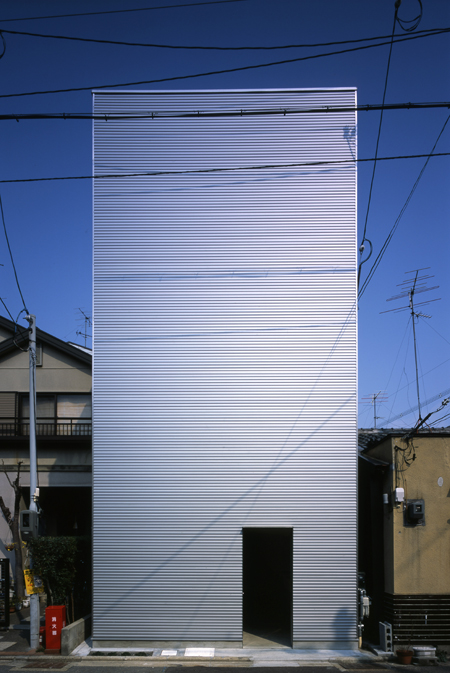- Eleonora Usseglio Prinsi talks with Kochi Architects, OFDA Associates and ALPHAville about creating new ways to live in Japanese domestic spaces

For a long time Japan has been a source inspiration for Western architects: from Frank Lloyd Wright to Charlotte Perriand, architects are fascinated with the idea and role of Oriental culture, with this influence pervading from blogs to the most important architectural awards, and the new season opening with (already) iconic projects such as those of Tadao Ando and Kazuko Sejima.But what is the role of Japanese housing design now, and how has it evolved? We talk with some of Japan’s most en vogue architecture practices- Kochi of Kochi Architect’s Studio, Hiroyuki Ito of OFDA, and Kentaro Takeguchi and Asako Yamamoto of ALPHAville.
“After the end of World War II in Japan, a lot of houses were built during a period of high economic growth. However, since 2004 the Japanese population has begun to decrease, signifying the end of practical domestic design: we now need experimental design for the home” explained Kazuyasu Kochi. “Simultaneously, as almost all Japanese houses are detached, the role of Japanese housing design is to create new forms of living with new forms of architecture.”
Left: Interior of the Amida House, by Kochi Architects.
Image Kei Sugino Kei Sugino
- But there aren’t just historical factors that account for an increased interest in housing design in Japan. “The widely spread suburbs of Tokyo provide young architects with good opportunities to design and improve their skills, whilst facing many difficulties, such as a rainy climate, frequent earthquakes, small plot sites etc” explains Hiroyuki Ito of OFDA. “In particular, the lack of space leads them to develop a mature consideration of living and environment. This often excuses a lack of specific housing features such as windows, partition walls, or exterior walls, bringing about extraordinary situations.”
Tatami mats, fusumas and futons have been essential to the creation of the distinctively “Japanese” interior. However, flicking through images of contemporary Japanese homes, this aesthetic seems completely lost. What has changed to stimulate this development in residential design?
“Traditional Japanese homes are divided into small rooms by sliding doors called “fusumas”. This system of thin partitioning brought forth a sensitivity regarding the layout of rooms, as well as the rules of living, and the sense of space depth. This consideration is shared amongst Japanese architects when creating attractive spaces, despite particularly cramped quarters” said Hiroyuki Ito of OFDA. “Our traditional architecture has aflexible system enabling a building to adapt to the mountainous landscape. It doesn’t confront the natural environment, but rather accepts it – a feature not so readily seen in countries such as China. Contemporary Japanese homes seem to have the same relations with the city surroundings: most cityscapes of Japan are not regarded highly from an urban planning point of view, but the recent proliferation of well designed homes is redefining this.”
 Above: Exterior of W Window House by ALPHAville
Above: Exterior of W Window House by ALPHAville
 Above: Interior of the W WIndow House by ALPHaville, staircase and bespoke bookcase. Image Kei Sugino Kei Sugino
Above: Interior of the W WIndow House by ALPHaville, staircase and bespoke bookcase. Image Kei Sugino Kei SuginoThe organisation of Japanese urban planning could also be seen as an element further developing design in the opinion of Alphaville architects: “In these urban Japanese cities, nobody knows their neighbours, as those living in cities overseas might. But after the 3.11 Earthquake [2011 Tohoku Earthquake], we find the concept of community becoming more important, as we try to co-exist in this space of privacy and openness. Our design philosophy gives residents the option to experience multiple contexts: we believe architecture should be three-dimensional, connected not only to the spatial aspects (like natural light, wind and sound), but to the urban environment, and the people around us too.”
Such big changes in the way of home design has led to natural developments in domestic interaction. This highlights change not only affecting structural elements, but also the jolt to cultural behaviours over a short period of time.
“Traditional Japanese Tatami mats were originally used in dining spaces with small low tables, and in bedrooms with futons. But now we have begun to adapt to the Western lifestyle of domestic interiors, where we use tables and chairs for dining, and beds in bedrooms. Recently we have begun to think about Western domestic lifestyle in relation to the small space of Japanese homes” explains Kazuyasu Kochi.
It could be argued that Japanese housing is the nth product of globalisation, an undefined mis-match of styles edging away from its cultural roots and looking for occidental models. But at the same time, the sheer interest in this Japanese phenomenon from Europe signifies a “continental longing” to develop our own serious experiments with the home unit, and our continuing dissatisfaction with out-of-the-box models of domestic living.
Subscribe to Port Magazine annually and receive each issue to your door.
Get PORT in print



